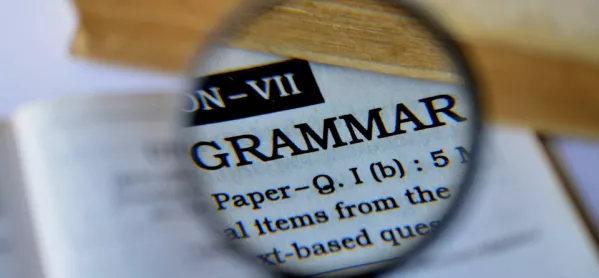- Home
- Why the way you talk about grammar really matters
Why the way you talk about grammar really matters

Before reading this column, ask yourself: what is grammar? How would you define it?
The chances are that your answers to these questions rely on some sort of metaphor. Perhaps you would say that grammar is the “structure” of communication, for example, or the “building blocks” of language, or the “rulebook” for using language.
Indeed, grammar is commonly defined using metaphors, because of its nature: it is abstract, complex, and can’t be seen or touched in the way that material entities can. Abstract things like “grammar” are often talked about using metaphor, because it allows us to talk about the abstract thing in a concrete way. In short, metaphor allows us to understand one thing in terms of another.
Some linguists argue that metaphor isn’t just a feature of language, but a deeper reflection of thought structure itself. If that’s the case, then the metaphors that teachers use for “grammar” clearly matter, because they reflect the way that teachers think about grammar, and theoretically impact on the way that grammar is taught in the classroom. So, if a teacher has a “murderer” metaphor underpinning their thoughts on grammar, thinking something such as “subordinate clauses can really kill a lesson”, then this has obvious implications for classroom practice.
Metaphors for grammar
With that in mind, let’s examine some of the most widely used metaphors for grammar. First up: “grammar is a rulebook”, which might yield expressions such as:
“It’s about being right or wrong with your language.”
“Grammar is about correctness and avoiding errors.”
“Grammar dictates what we can and can’t do with language.”
“The grammar police are out to get you.”
This is an interesting metaphor because it can potentially highlight a rather prescriptive view of grammar, where grammar is defined as a rigid list of rules and constraints. Sadly, this seems to be very much the metaphor that underpins much of the key stage 1 and 2 grammar, punctuation and spelling tests. It’s also a metaphor that clearly grounds a number of difficult correspondences:
rulebook grammar
rules → regular patterns in grammatical constructions
diversions from rules → irregular patterns in grammatical constructions
writers of rules → dictionaries; grammars; those that hold authority
overseers of rules → exam boards; teachers
sanctions and punishments → negative perceptions; feelings of fear
Of course, breaking the “rules” can be a useful way of exploring how writers do different things with language and deviate from expected patterns, which, in turn, can create some kind of effect with their readers.
The next metaphor that we’ll look at is the “construction” metaphor. Expressions that fall under this metaphor include:
“Grammar is the foundation of language.”
“It’s about designing and crafting language.”
“Grammar is the scaffolding that helps to provide meaning.”
“Grammar can be used to build fictional worlds.”
For us, this offers a more useful way of thinking about language, because it suggests that grammar is like architecture: designing, planning, making, constructing, rebuilding, and so on. It presents grammar as a series of individual parts that are put together to make something: a persuasive argument, a piece of literary fiction, and so on. Like the “rulebook” metaphor, it highlights pattern and order; but unlike a “rulebook”, it emphasises patterns as things we consciously craft in order to create some kind of desired aesthetic effect. We might then think about the correspondences in the metaphor as something like this:
construction grammar
nuts, bolts, paint, scaffolding, etc → word classes, phrases, clauses, functions
design and construction → speaking and writing
architects and builders → speakers and writers
collapse of a structure → ungrammaticality
Of course, there are other metaphors for grammar - and whilst we’re not suggesting that teachers only think about grammar in one single way, we hope that we’ve highlighted some of the ways in which metaphors can affect the way we think about grammar and grammar teaching.
Further reading
Kövecses, Z. (2010). Metaphor: A Practical Introduction. Oxford: Oxford University Press.
Lakoff, G. & Johnson, M. (1980). Metaphors We Live By. Chicago: University of Chicago Press.
Ian Cushing is a teaching eellow in English linguistics at University College London and a doctoral researcher in applied linguistics at Aston University. Mark Brenchley is an associate research fellow at the Centre for Research in Writing at the University of Exeter. He works on the Growth in Grammar project, which is seeking to understand what grammatical development in student writing actually looks like
Want to keep up with the latest education news and opinion? Follow Tes on Twitter and like Tes on Facebook
Keep reading for just £1 per month
You've reached your limit of free articles this month. Subscribe for £1 per month for three months and get:
- Unlimited access to all Tes magazine content
- Exclusive subscriber-only stories
- Award-winning email newsletters



